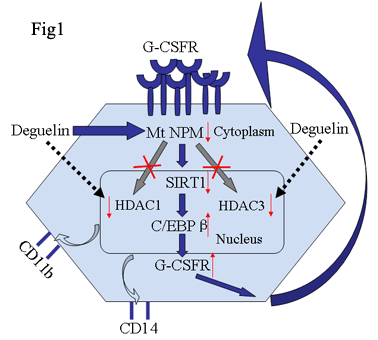Abstract
AML with NPM1 mutation (Mt NPM1) showing aberrant cytoplasmic dislocation of NPM1 exhibit relative good response to induction therapy, however, still a proportion of NPMc+ AML can not be cured by conventional treatments. Therefore, the aim of the present study was to determine the therapeutic efficacy of deguelin, a natural rotenoid isolated from several plant species, which has been demonstrated extensive biological activity in various tumors with low lethal effect. In the 54th ASH meeting in 2012, we reported deguelin selectively reduced Mt NPM1, induced differentiation and potentiated apoptosis in acute myeloid leukemia cells carrying NPM1 mutation.
In this paper, we will focus on the investigation of the effect and molecular of mechanisms of deguelin treatment in nontoxic concentration with long time duration on AML cells carrying Mt NPM1. Deguelin treatment at the differentiation-induced concentration of 2µM for 5 days significantly induced granulocytic/monocytic differentiation such as a lower nucleocytoplasmic ratio, peripherally located nucleus, and chromatin condensation in 66.7% of OCI-AML3 cells carrying Mt NPM1. However, these phenomena were not presented in the OCIM2 cells harboring Wt NPM1. The NBT reduction assays that used as another marker of differentiation of myeloid leukemia exhibited increased NBT reduction activity, and Fluorescence-activated cell sorting (FACS) analysis demonstrated significantly increased expression levels of CD11b/CD14/CSF-3R in deguelin-treated OCI-AML3 cells (CD11b: from 2.8% to 62%; CD14: from 2.6% to 32.3%, CSF-3R: from 0.7% to 21.6%, P£¼0.01). Furthermore, immunoblot analysis revealed deguelin significantly reduced the levels of Mt NPM1 and HDACs (HDAC1/HDAC3/SIRT1), but not Wt NPM1, accompanied by increasing the expression of proteins and mRNAs of CEBP¦Â and G-CSFR. In addition, immunoprecipitation and immunoblot analysis confirmed deguelin significantly down-regulated Mt NPM1 via the ubiquitin-proteasome pathway. In consistent with above results, sh-Mt NPM1 and sh-SIRT1 treatment induced differentiation of OCI-AML3 (sh-Mt NPM1: CD11b/CD14/CSF-3R respectively: from 15.5% to 62.3%; from 13.9% to 47.1%; from 0.6% to 18.4%; sh-SIRT1: CD11b/CD14/CSF-3R respectively: from 18.2% to 47.1%; from 19.2% to 43.7%; from 0.4% to 13.4%, P£¼0.01), which confirmed by morphological examination and NBT reduction assays, and also upregulated the levels of proteins and mRNAs of CEBP¦Â and G-CSFR. sh-Mt NPM1 treatment reduced the expression of SIRT1, which did not change the levels of HDAC1/3. In other sides, sh-SIRT1 treatment did not alter the levels of Mt NPM1, suggesting that the decline of SIRT1 was partially accountable for granulocytic/monocytic differentiation of AML cells with Mt NPM1. Finally, overexpression of Mt NPM1 was performed to determine whether the depletion of Mt NPM1 directly induces granulocytic/monocytic cell differentiation. Compared to GFP-expressing cells, the proportion of the differentiation antigens (CD11b/CD14) and differentiation gene CSF-3R declined in Mt NPM1-expressing cells after deguelin treatment (Mt NPM1-expressing-treated deguelin-induced CD11b/CD14/CSF-3R-positive cells respectively: from 47.5% to 23.1%; from 29% to 18.8%; from 23.2% to 6.5%, P£¼0.01). Importantly, the upregulation of CEBP¦Â and G-CSFR by deguelin was appreciably hampered in Mt NPM1 expressing cells, compared with GFP-expressing cells.
Taken together, our studies suggest deguelin, selective silencing of Mt NPM1, which induces differentiation via the axis of SIRT1/CEBP¦Â/G-CSFR (Fig1) may represent a novel active differentiating agent like ATRA for NPMc+ AML.
Footnotes* Asterisk with author names denotes non-ASH members
No relevant conflicts of interest to declare.
Author notes
Asterisk with author names denotes non-ASH members.


This feature is available to Subscribers Only
Sign In or Create an Account Close Modal